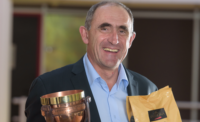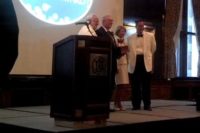Visitors to Patrick Huffman’s office can’t help but notice several of the awards he’s gathered during his 40-plus years in the confectionery industry. There’s the Stroud Jordan award from the American Association of Candy Technologists (AACT) he picked up in 1992. Next to it sits the National Confectioners Association’s Distinguished Service Award, which he received in 2010.
This year, Huffman, president and coo of the Warrell Corp., became the 68th Kettle Award recipient. The copper kettle mounted on a walnut base beams brightly on the same shelf.And later this year, he will be inducted into the Candy Hall of Fame.
But anyone who’s met Huffman or worked with him realizes Huffman doesn’t do what he does in order to fill up a trophy case. If there ever was a “candy man’s candy man,” then Huffman fills the bill. As David Hess, v.p. of operations for the Warrell Corp. and himself an experienced candy maker and executive plainly states, “Pat’s the best I’ve met in the industry. He has character, business ability and Technical expertise. Many people have two out of three; he’s has all three.”
High praise coming from an accomplished colleague. But then Huffman’s resume bears witness to a varied and expansive career, one that encompasses stints with family-run businesses as well as multinational operations.
It’s a curriculum vitae of such depth and breadth that it bestows upon Huffman a certain confectionery gravitas, most deservedly ascertained by the Kettle Award this year.
For example, when Huffman started working for the Paul F. Beich Co. In Bloomington, Ill. In 1969, William Beich, the founder’s grandson and chairman of the company, took a particular liking to the young plant manager.
As Huffman explains, “Thanks to Bill, I saw 250 plants before I was 25. He would send me all over the world.”
During those trips, the young plant manager would not only take in the latest developments in confectionery processing and automation, but also have an opportunity to see specialized, handcrafted techniques. Few in the industry enjoyed such privileges.
Nonetheless, Huffman’s travels weren’t the only learnings he received from Beich.
“Bill would infuriate me all the time,” Huffman says. “Here I’d have my hands in chocolate, trying to get our moulding line going while several disgruntled women were complaining loudly when Bill would come over and show me items he had picked up while walking the plant, stuff like cigarette butts from the sand-packed ash trays. Then he’d ask me, ‘Pat, can you take care of this?’”
Only several years later did Huffman began to understand the nuance behind the aggravation.
“As Bill told me later on, ‘You know, Pat, there’s a lot less that I’m bringing to your attention,’” he continues. “As he explained to me, ‘I knew you’d never miss the big things; it’s the little things that I wanted you to see.’”
And that’s where Huffman learned that the slowest plant walks can be the most important ones, particularly when it comes to viewing what employees, as well as supervisors are doing. Of course, it not just a matter of observing what’s going on; it’s the follow-through that’s even more important.
As the Warrell executive emphasizes, not only is it important to stay focused on the task at hand, but it’s even more important to stay committed to that task. It’s a management style that’s direct and to the point.
“It’s really a matter of remembering what we did today as well as what we agreed to do tomorrow. And tomorrow, I’ll remember what we agreed to do,” he says.
It’s that kind of straightforward, no-nonsense directive that has helped the Warrell Corp. flourish under Huffman’s leadership. During the past 10 years, the company has posted a 14 percent average annual growth rate. Candy Industry Estimates 2012 sales for the Camp Hill, Pa.-based company exceeded $70 million.
Under Huffman, the company has attained ISO 22000, FSSC 22000 and ISO 9001 certifications, one of the first diversified manufacturing companies to do so, points out Kevin Silva, senior v.p. of administration at Warrell Corp. Despite the angst often associated with such certification processes, the company diligently tackled the requirements.
“In the end, ISO certification is really simple,” says Huffman. “You say what you’re going to do, then you do what you say, and finally, you write it all down.”
For the Warrell Corp., such certifications represent the “backbone” of what the company’s all about. As a major contract manufacturer for the Top 10 food companies in the world, consistent quality and measurable efficiencies dictate success.
In quoting American novelist Ellen Glasgow, “All change is not growth, as all movement is not forward,” Huffman points out that oftentimes “there’s lots of noise and heat, but no light,” in initiating improvements in a company or a manufacturing facility
“What’s important is that you move forward a little bit every day; otherwise someone will move you backward,” he says. “When you have a big plant [Editor’s note: Warrell’s Camp Hill facility covers 219,000 sq. ft. While its York, Pa.Factory is 43,000 sq. ft.], there are large fixed costs, people are spread out.
“The goal is to make processes as efficient as possible, be it in the design of the equipment or the plant,” he continues.“It’s also about maintaining the business by watching your p’s and q’s.”
Huffman has seen to it that the company has done all of those. Most recently, Warrell Corp. has installed a Sollich Conbar line, which will allow it to produce a variety of bar products more efficiently and with more flexibility.
It also added a Bosch vertical form/fill/seal bagging machine, one that has the capability to handle high-speed pillowstyle bags, flat-bottomed bags and four-corner, quad-seal bags.
Then there’s the addition of two new enrobing lines (a Sollich and MF Hamburg enrober complement an existing Chocotech enrober), which reflect the company’s steady growth in sales.
“When we enrobe pretzels today, the pretzels are touching one another as they head toward the enrober,” Huffman says. “Once enrobed, they separate and cool. That’s what enrobers are supposed to do. It’s all about efficiency, which is often just common sense.”
Vision also helps. In 2009, Huffman lobbied strongly for the company to acquire Lukas Confections, now known as Classic Caramel, a wholly owned subsidiary of the Warrell Corp. Although it took about three years and a new plant manager to turn around the bankrupt company, the move is not only paying off, it’s providing the company with new opportunities.
As Silva points out, in 2009, Classic Caramel produced only 300,000 lbs. Of caramel. Today, it’s turning out 3 million lbs. It’s also giving Warrell the capability to produce new branded and contract-manufactured items, such as a nut cluster or caramel centers.
The impetus behind acquiring Classic Caramel was threefold, explains Huffman. First, it allowed Warrell to simultaneously vertically integrate its caramel-making capability. This, in turn, opened up opportunities to sell branded caramel items. It is also expanding prospects of Selling caramel as an ingredient to other food companies.
And while acknowledging it has taken time to transition Classic Caramel into a profitable subsidiary — the company has invested more than a million dollars in equipment and infrastructure upgrades — the payback is now there and will be even more so in the future.
Another recent investment, to the count of $500,000, is the implementation of a new Enterprise Resource Planning (ERP) software system. It will integrate two existing data base systems as well as external operations, such as a website, into one.
As Osher Yam, v.p. of finance for the Warrell Corp. points out, when he joined The company in 2004, a similar software investment totaled $40,000. The new ERP software — which is used by hundreds of thousands of companies throughout the world — reveals how far the company’s come in the last decade.
“Pat has changed the organization, implementing many changes, all of which were for the good,” says Yam. “The company has more structure, more processes, more customers. He’s very detailed and has a strong analytical mind, providing you reasons for a specific decision.”
All of those changes are geared toward further strengthening Warrell Corp. for the future, particularly as the second generation takes over operations.Huffman, who’s slated to retire Jan. 2016, Recognizes his responsibility to ensure a smooth transition upon his departure.
Linc Warrell, chairman of Warrell Corp. and a 2004 Kettle Award recipient, has passed the baton to Silva and Richard Warrell, v.p. of sales and marketing. As family members, who are directly involved in the business— Silva is Linc’s son-in-law while Richard is Linc’s youngest son —the two are designated to take over the reins upon Huffman’s departure.
Given their distinct responsibilities — Silva oversees quality assurance, food safety, quality control, while Richard focuses on the company’s branded operations, which includes the company’s Pennsylvania Dutch business and an emerging portfolio of Warrell Corp. brands, such as Classic Caramel, Katharine Beecher and Craveemmm lines, as well as contract manufacturing accounts — the pair stand poised to make their mark.
In the interim, Huffman has set a goal for the company: $100 million in sales by 2015. That goal, albeit lofty, is attainable, the president and coo, believes.And there’s something in Huffman’s office that symbolizes his belief.
And no, it’s not this year’s copper Kettle Award, nor the Stroud Jordan or Distinguished Award crystal pieces. A framed print of a Michael Sowa’s painting showing a pig diving off a pier in a bucolic setting whimsically affirms the notion that “Pigs can sometimes fl y.” In other words, ambitious goals are doable.
Despite the lofty $100-million sales target, Silva recognizes that if anyone can make that goal happen, it’s Huffman.
“He’s intense and has strong opinions, backed by a wealth of business and technical experience.”
In addition, he’s got a sixth sense about things.
“Pat’s experience helps prevent problems before they happen, “adds Hess.
Within that context, it’s important to remember that Huffman’s Affinity for the Sowa print reflects his perspective on working in the industry, which is a sweet one.
“When people ask me what I do and I tell them that I’m a candy maker, they Immediately smile,” Huffman says.
“Then someone will tell me that they were in a candy plant once and they really enjoyed it. So how can you not laugh and enjoy what you do when people smile upon hearing you make candy?”
Indeed, seems everyone at Warrell Corp. as well as the industry are smiling that Huffman was selected as Candy Industry’s 68th Kettle Award recipient.



























